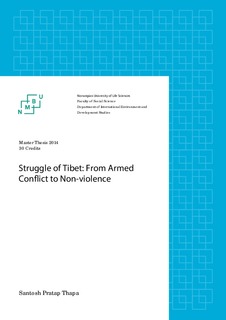| dc.description.abstract | The conflict between Tibet-China has been going on since 1950s. Chinese has proclaimed Tibet as an alienable part of her mainland where as Tibetans have distinct view regarding the issue. Tibetan spiritual leader and his followers fled to India in 1959 due to the invasion made by Mao Tse-tung and his PLA. Tibetans tried to regain their homeland by the armed struggle with the support of CIA. The movement was known as Khampa gurreilla warfare which they fought until 1974 from the Mustang base, territory of Nepal. The changing international political realm could not further advance their war and ended with betrayal, laying down the weapons, and surrender to Nepalese Army. It was because of the growing relationship between US and China. Even though US government had inclusive nature on her foreign policy during the cold war which was against the communist ideology but Nixon agreed to recognize Tibet and Taiwan belong to the Chinese mainland. In the 80s, Deng Xiaoping and Hu Yaobang offered the exiled Tibetan leaders to ‘‘return to the motherland’’ where they proposed except independence, everything was supposed to be settled. That’s why, the Dalai Lama quit the concept of independent Tibet and accepted Deng’s offer for the welfare of Tibet and her people. But, the negotiation was not smoothly undertaken when the Dalai Lama awarded the Nobel Peace Prize in the year of 1989. Chinese blamed him as ‘‘seperatist and friend of western hostile forces’’ and ignored the concept of Greater Autonomous Tibet and his non-violent path which he had put his argument in Strasbourg (1988) and US Congressional Human Rights Caucus (1987). The deadlock is sometimes got opened and almost no talk at all. The desirable returning interest of Tibetan exiled people and the Chinese negative argument towards the the Dalai Lama and his exiled government have not got any solution at this moment. Tibetans have claimed that there has been lots of human rights violation going on inside Tibet, the religion of Tibet has been charged for anti-religion of China, population transfer is increasing, discriminatory rule for Tibetans, the culture and art of Tibet have been destroyed, arbitrary detention etc. The main theme of writing this paper is to open the deadlock in the ground of negotiation and peaceful means. Violation and anger never support for the true relationship but enhances the environment beyond to the solution. If necessary, to resolve this issue, China and Tibet may friendly invite any international body like UN or neighbour countries like India to find the solution at any time. The newly elected Prime Minister of India is willing to enhance friendly relationship with China. If India shows her interest on solving the issue, then Tibetans will definitely benefit from this negotiation for the future perspectives. | nb_NO |

